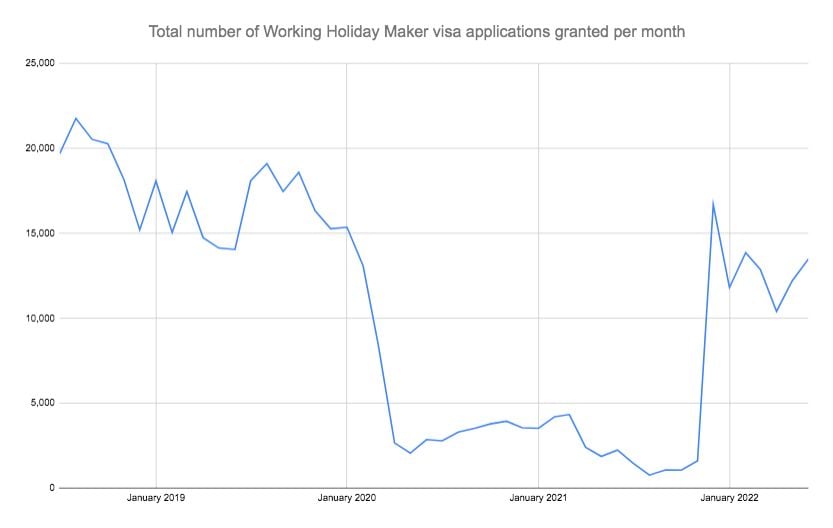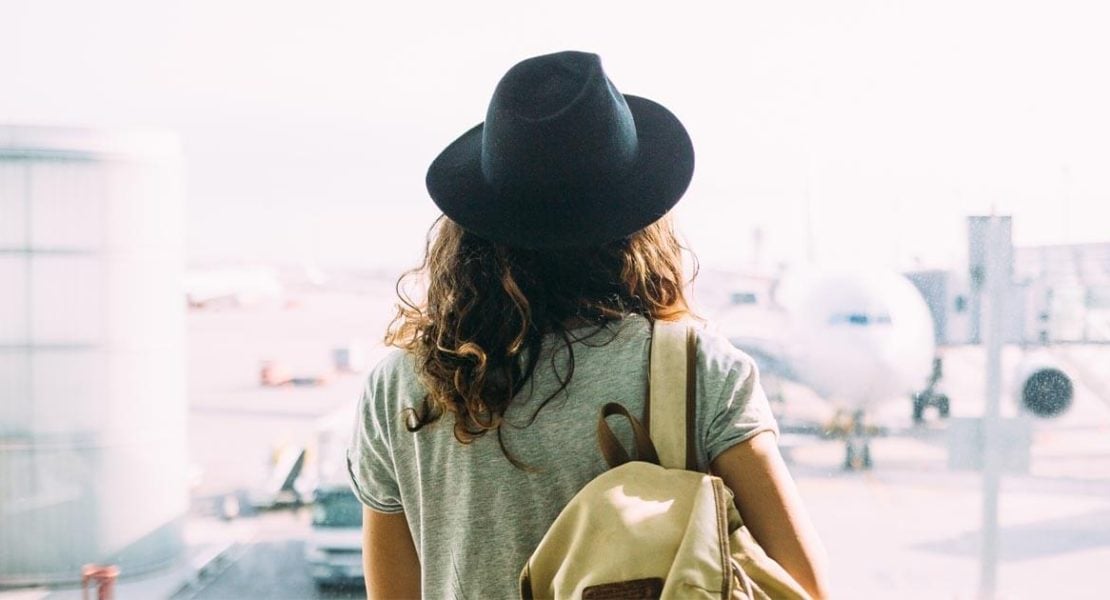How Covid impacted Australia’s backpacker industry
Backpacker Job Board is thrilled to announce that backpackers are back!
It’s been nearly three years since the pandemic first impacted so many industries and there’s still a long road to recovery ahead – but for now – the numbers are showing a bumper summer season ahead.
We are currently seeing the number of working holiday makers applying for jobs through Backpacker Job Board surge month on month.
“It’s a huge relief to finally see backpackers returning in numbers.” says Backpacker Job Board founder, Matthew Heyes. “There’s so many industries which rely on this vital workforce. Employers up and down the country are breathing a sigh of relief as recruitment is getting easier.”
👉 Data from the Australian Government’s HomeAffairs website states a total of 97,359 Working Holiday Maker visas were granted from 1 July 2021 to 30 June 22.
👉 In October 2022, The Australian newspaper reported how backpackers were returning despite the cost of air travel. “Australian Chamber of Commerce and Industry Tourism chairman John Hart said backpacker numbers were at about 60 per cent of pre-Covid levels.”
👉 Now, as we near the end of the year, Backpacker Job Board is currently experiencing website traffic at 85% compared to the end of 2019. The number of job seekers using the platform in November 2022 is 70% compared to November 2019. While we are already receiving more job advertisements each week compared to pre-covid levels.
👉 All the metrics are expected to reach and exceed pre-covid levels in January-February of 2023.
So how many backpackers are currently in Australia?
Assuming the recovery is between 60% and 70% of precovid levels, there is likely to be approx 90,000 working holiday makers currently in Australia (at the time of writing, December 2022).
This would marry accurately with the trend that in August 2022 there were 54,025 Working holiday visa holders in Australia.
Timeline: Working Holiday Makers through COVID
January 2020: Pre-COVID, business as usual.
On the 19th of January a man travelled from Guandong, China to Melbourne. On the 25th he became Australia’s first confirmed case of COVID-19.
Backpacker count: approx. 130,000
March 2020: Border restrictions are enforced.
Over February and March COVID spreads to every Australian state and territory. Beginning with Tasmania on the 19th of March, state governments announce measures to restrict movement across state borders.
On the 20th of March Australia’s border closes to all non-citizens and non-residents (although international departures are still available.) This marks the first direct impact on backpacker-reliant businesses, as working holiday makers can no longer travel into or around Australia unrestricted.
Backpacker count: approx. 119,000
April 2020: Government advises backpackers to go home.
On the 3rd of April 2020 then-Prime Minister Scott Morrison holds a press conference in which he advises international students and working holidaymakers who cannot support themselves “to return to their home countries”, adding “it’s time to make your way home.”
Backpacker count: approx 115,000
December 2021: International borders reopened to working holiday makers.
On the 15th of December 2021, having been closed for 635 days, Australian borders reopen to working holidaymakers. The government announces that all eligible visa holders, including those with working holiday visas, are once again welcome on Australian shores. (The borders reopen completely on the 21st of February 2022.)
Backpacker count: approx. 19,000
January 2022: Free working holiday visas announced.
On the 19th of January 2022, in an effort to increase the influx of working holidaymakers, the Australian government announces that the Visa Application Charge (VAC) of $495 will be fully refunded to any working holiday visa holder that arrives in the country by the 19th of April. It also offers more flexibility, announcing that in 2022 any working holidaymaker in Australia can work for the same employer for more than six months without needing to request permission from the Australian government.
Backpacker count: approx. 21,000
July 2022: A slew of more generous WHV policies implemented.
The Australian government announces a number of changes to the working holiday visa program will come into effect on the 1st of July 2022. These are designed to attract more backpackers, and include:
- A 30% increase in the number of places available in the program for 2022-2023.
- Opening up the program to residents of Brazil, India, Switzerland and Mongolia.
- No VAC until 31 December 2022 for eligible current and former working holidaymakers.
- An increase in age limit from 30 to 35 for Italian and Danish working holidaymakers.
Backpacker count: approx. 40,000
October 2022: Meaningful recovery.
In October, it is estimated that around 75,000 visa holders are currently offshore. And it’s reported that the arrivals are at 60% of precovid levels.
Backpacker count: estimated 90,000 in December 2022.

The impacts on backpacker-reliant industries
With the number of working holiday makers in Australia dropping from a pre-COVID high of 140,000 to a December 2021 low of just 19,000, backpacker-reliant employers across the country have felt the pinch over the last two and a half years.
While the ‘Fortress Australia’ policy ensured the Australian population was protected from the health effects of the pandemic better than almost any other, businesses weren’t so lucky.
Over the years key areas of the country’s economy have become reliant on a steady flow of overseas labour, primarily in the form of working holidaymakers and international students.
As soon as backpackers began leaving in droves – at the government’s behest, as noted above – a number of key industries began to be disrupted. These notably included:
Agriculture
Fruit picking and other casual farm work is a rite of passage for backpackers in Australia, so much so that it is ingrained in the terms of the working holiday program itself: in order to secure a second-year visa most backpackers must complete three months of ‘specified work’.
It is currently estimated that there are 172,000 unfilled jobs across the food supply chain (a figure that includes elements of the hospitality industry).
And even for farmers who manage to attract workers, a housing crisis in regional Australia means it can be difficult to find somewhere to house them.
Tourism and hospitality
From Far North Queensland hostels, to Sydney tour operators, to Melbourne cafes, a broad range of businesses are reliant on a regular flow of casual workers to fill their shifts, and this flow was boosted greatly by the working holiday visa program.
The Restaurant and Hospitality Industry Association currently estimates a shortfall of over 100,000 workers. While the recent 50-year low in the unemployment rate has contributed to this figure, the body says that a huge proportion of these now empty roles were previously taken up by backpackers in seasonal areas.
Childcare/ Au pair work
In May 2022, it was reported that Australia’s childcare industry was in desperate need of 16,000 workers. While low pay and high stress were identified as key factors in this shortfall, another was the lack of international au pairs, who helped to take pressure off childcare centres and their workers.
While far from a complete list, these three industries alone currently have almost 300,000 open roles that could be largely filled by working holiday makers. If Australia continues to attract backpackers at the current rate of 6,000 per month, it would take over four years to fill the roles above, and that’s under the presumption that no workers leave, which they’d be forced to do under current visa terms.
What’s next?
In terms of working holiday makers, the good news is that Australian borders are open, with no genuine prospect of closing again due to COVID. The current rules also make working holiday visas more tempting and easier to secure than they’ve been in years.
Europeans form the majority of working visa holders who come to Australia. Faced with instability and inflation caused by Russia’s invasion of Ukraine, they may see a move to the other side of the world as increasingly appealing.
For Brits, the Australia-UK Free Trade Agreement (FTA) has been signed and is due to come into force at some point in the next 14 months. It brings some particularly generous conditions to the bilateral working holiday agreement between the countries: applicants can be up to 35 years old and can stay for up to 3 years.
Bad news for the agri sector is that there will be no requirement for Brits to undertake any “specified work” in order to secure the second- and third-year visas.

